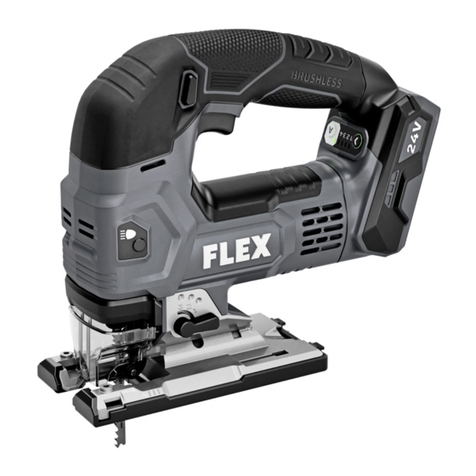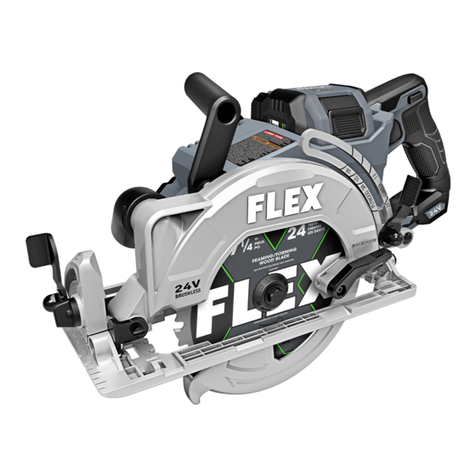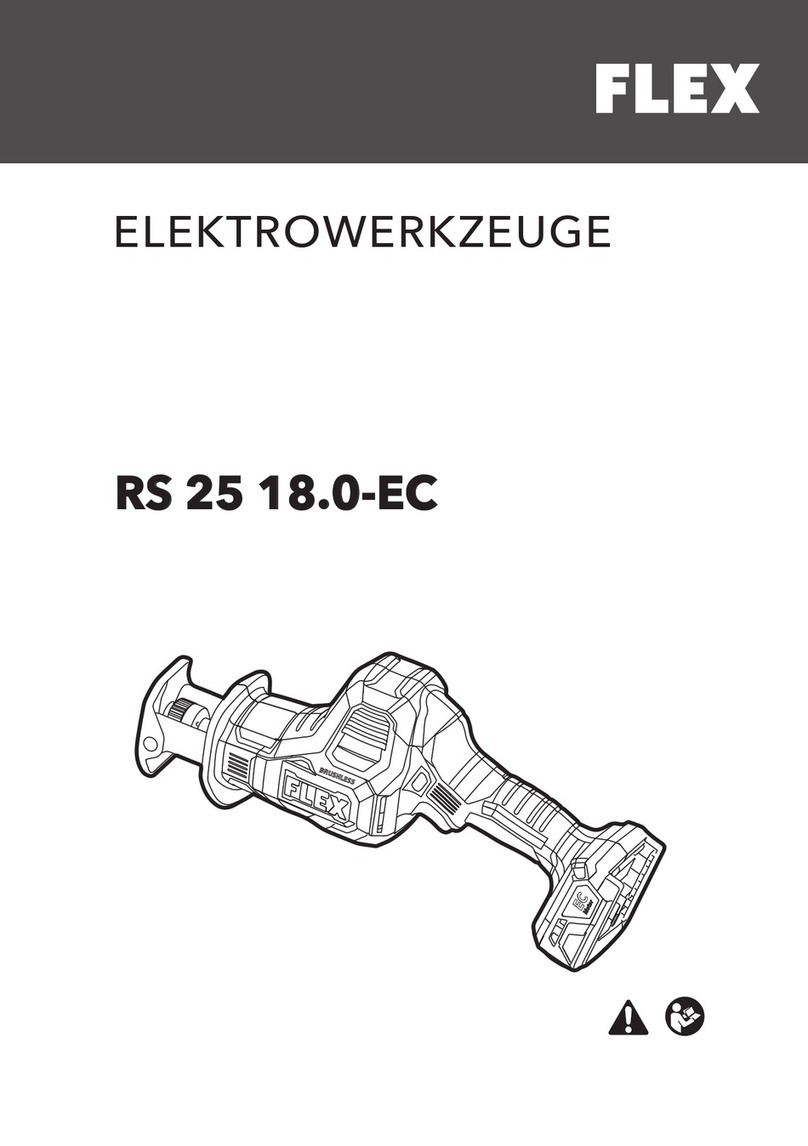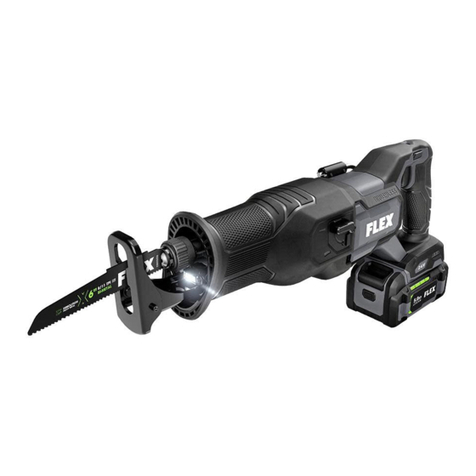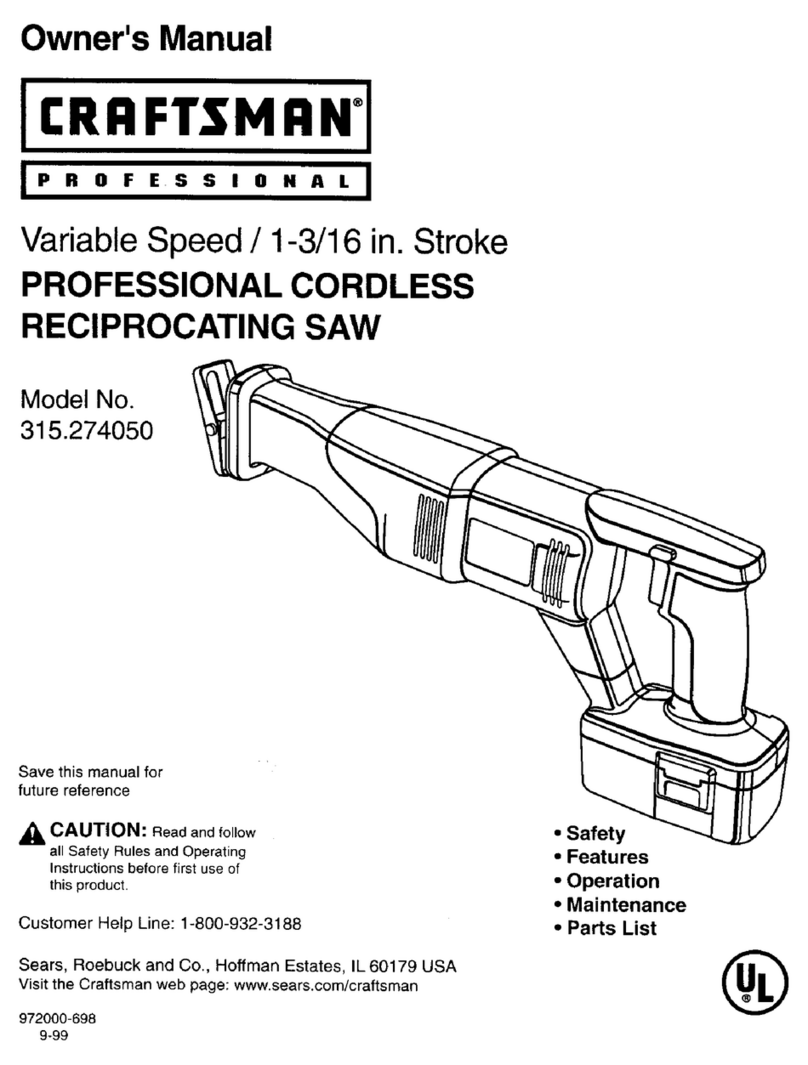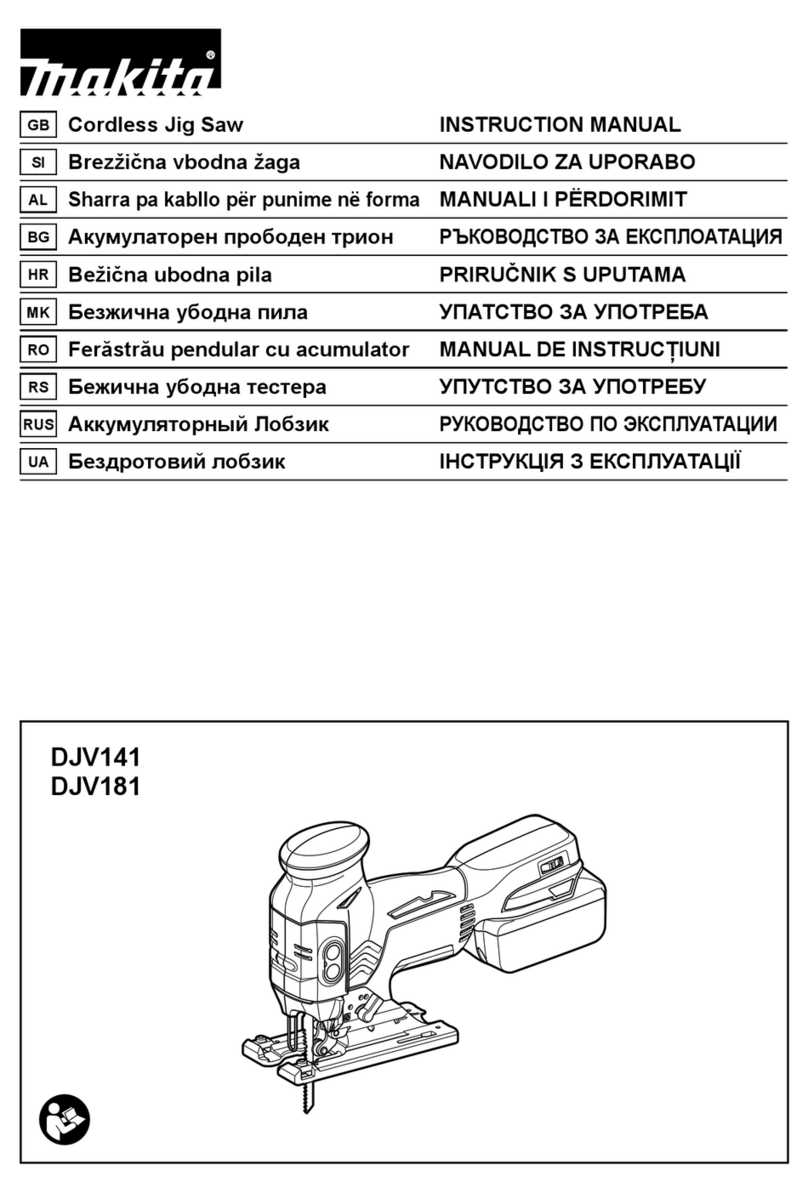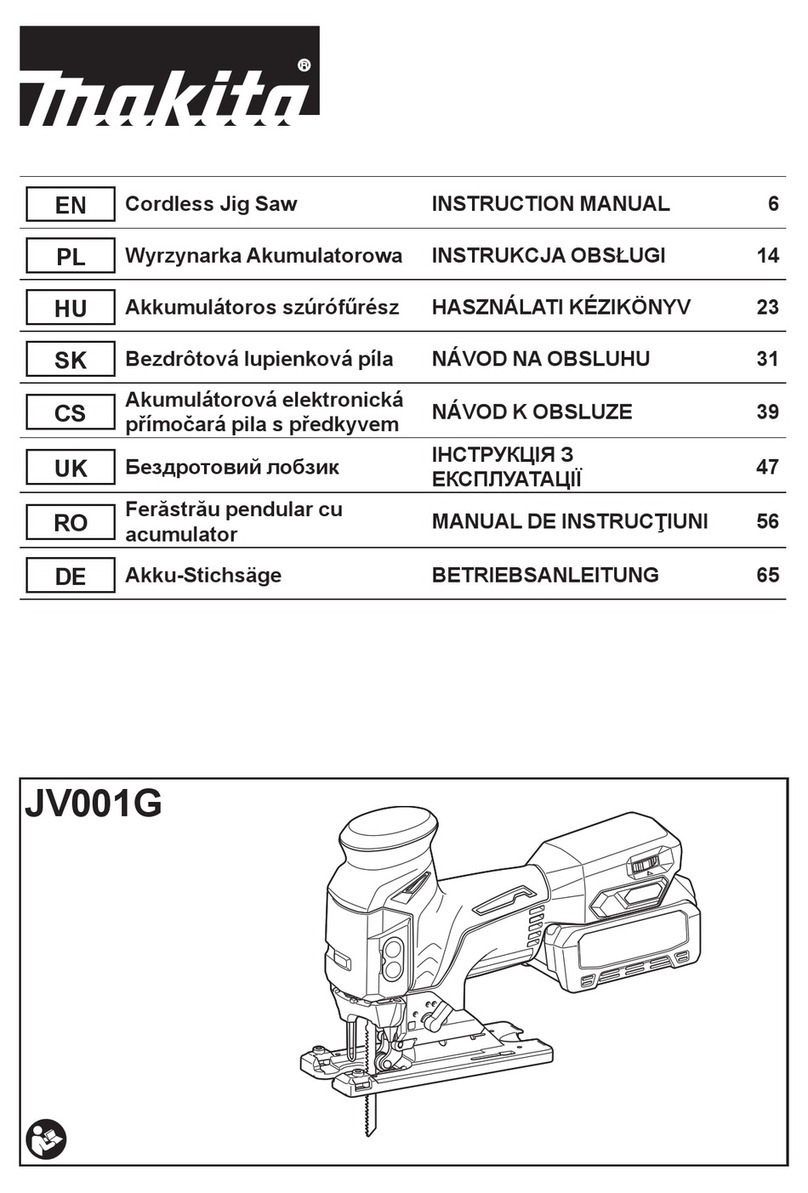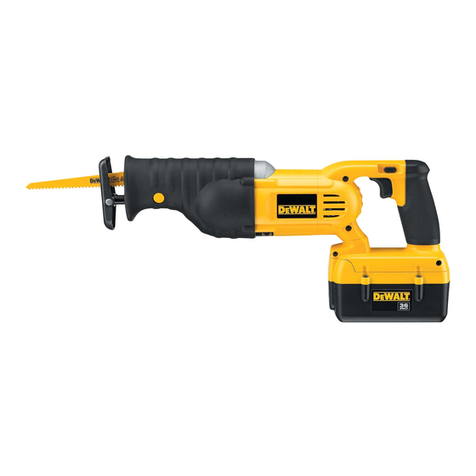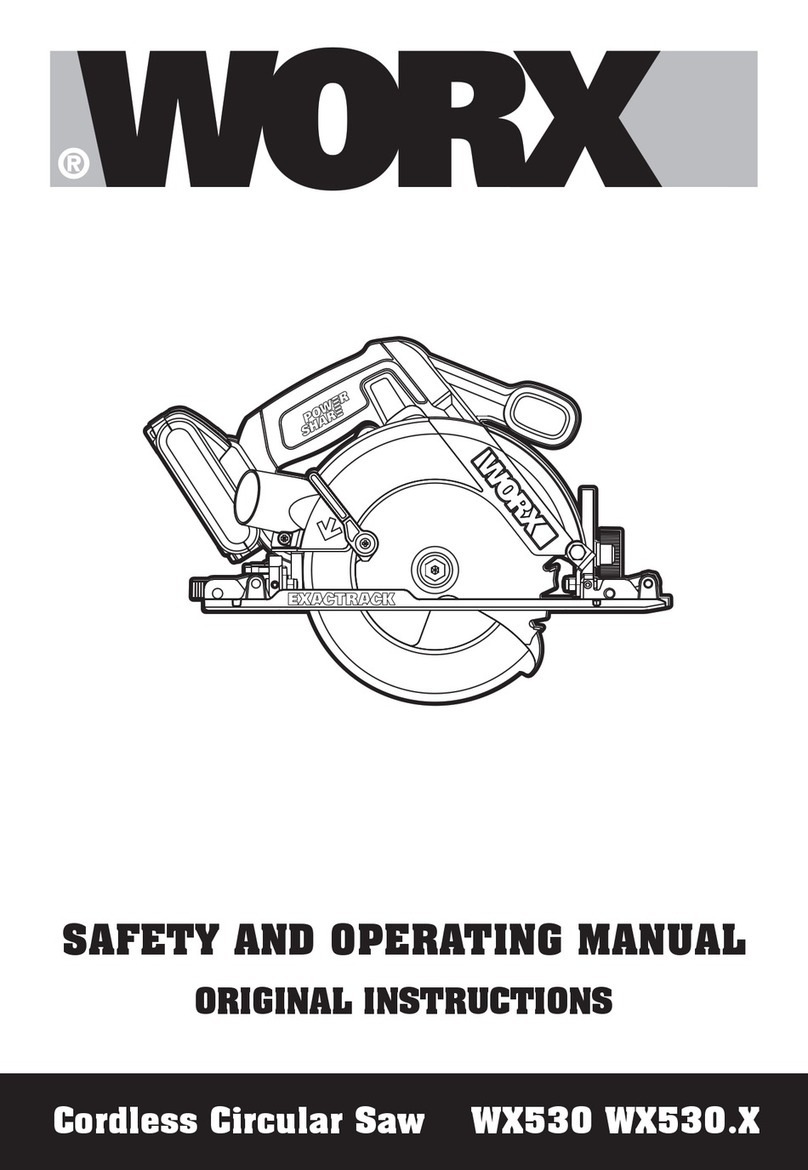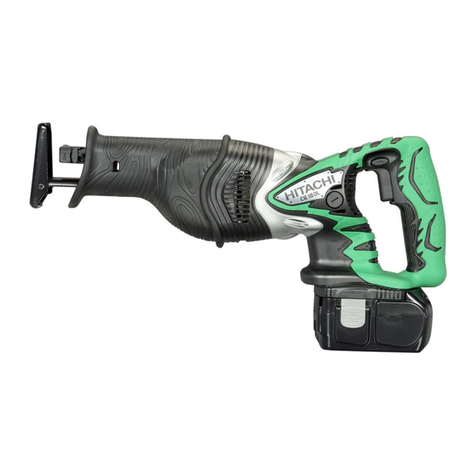Flex FX2221 User manual

Model:
Modelo:
Modèle:
OPERATOR’S MANUAL
MANUAL DEL OPERADOR
MANUEL DE L’UTILISATEUR
833-FLEX-496
(833-3539-496)
For English
Version
See page 2
◆
Version
française
Voir page 24
◆
Versión en
español
Ver la página 48
www.Registermyflex.com
Contact Us /
Nous contacter /
Contáctenos
24V CORDLESS JIG SAW
SCIE SAUTEUSE SANS FIL DE 24 V
SIERRA CALADORA INALÁMBRICA DE 24 V
FX2221

-2-
SAFETY SYMBOLS
The purpose of safety symbols is to attract your attention to possible dangers. The safety symbols
and the explanations with them deserve your careful attention and understanding. The symbol
warnings do not, by themselves, eliminate any danger. The instructions and warnings they give are
no substitutes for proper accident prevention measures.
WARNING Be sure to read and understand all safety instructions in this Operator’s Manual,
including all safety alert symbols such as “DANGER,” “WARNING,” and
“CAUTION” before using this tool. Failure to follow all instructions listed below may result in electric
shock, re, and/or serious personal injury.
The denitions below describe the level of severity for each signal word. Please read the manual and
pay attention to these symbols.
This is the safety alert symbol. It is used to alert you to potential personal
injury hazards. Obey all safety messages that follow this symbol to avoid
possible injury or death.
DANGER DANGER indicates a hazardous situation which, if not avoided, will result in
death or serious injury.
WARNING WARNING indicates a hazardous situation which, if not avoided, could result
in death or serious injury.
CAUTION CAUTION, used with the safety alert symbol, indicates a hazardous situation
which, if not avoided, will result in minor or moderate injury.
Damage Prevention and Information Messages
These inform the user of important information and/or instructions that could lead to equipment or
other property damage if they are not followed. Each message is preceded by the word “NOTICE”,
as in the example below:
NOTICE: Equipment and/or property damage may result if these instructions are not followed.
WARNING The operation of any power tools can result in foreign
objects being thrown into your eyes, which can result in
severe eye damage. Before beginning power tool operation, always wear
safety goggles or safety glasses with side shields and a full face shield when
needed. We recommend a Wide Vision Safety Mask for use over eyeglasses
or standard safety glasses with side shields. Always use eye protection which
is marked to comply with ANSI Z87.1.

-3-
GENERAL POWER TOOL SAFETY WARNINGS
WARNING Read all safety warnings, instructions, illustrations and specications
provided with this power tool. Failure to follow all instructions listed below may
result in electric shock, re and/or serious injury.
SAVE ALL WARNINGS AND INSTRUCTIONS FOR FUTURE REFERENCE.
The term “power tool” in the warnings refers to your mains-operated (corded) power tool or battery-
operated (cordless) power tool.
Work area safety
Keep work area clean and well lit. Cluttered
or dark areas invite accidents.
Do not operate power tools in explosive
atmospheres, such as in the presence of
ammable liquids, gases or dust. Power
tools create sparks which may ignite the dust or
fumes.
Keep children and bystanders away while
operating a power tool. Distractions can cause
you to lose control.
Electrical safety
Power tool plugs must match the outlet.
Never modify the plug in any way. Do
not use any adapter plugs with earthed
(grounded) power tools. Unmodied plugs
and matching outlets will reduce risk of electric
shock.
Avoid body contact with earthed or
grounded surfaces, such as pipes, radiators,
ranges and refrigerators. There is an
increased risk of electric shock if your body is
earthed or grounded.
Do not expose power tools to rain or wet
conditions. Water entering a power tool will
increase the risk of electric shock.
Do not abuse the cord. Never use the cord
for carrying, pulling or unplugging the
power tool. Keep cord away from heat, oil,
sharp edges or moving parts. Damaged or
entangled cords increase the risk of electric
shock.
When operating a power tool outdoors, use
an extension cord suitable for outdoor use.
Use of a cord suitable for outdoor use reduces
the risk of electric shock.
If operating a power tool in a damp location
is unavoidable, use a ground fault circuit
interrupter (GFCI) protected supply. Use of
an GFCI reduces the risk of electric shock.
Personal safety
Stay alert, watch what you are doing and
use common sense when operating a power
tool. Do not use a power tool while you are
tired or under the inuence of drugs, alcohol
or medication. A moment of inattention while
operating power tools may result in serious
personal injury.
Use personal protective equipment. Always
wear eye protection. Protective equipment such
as a dust mask, non-skid safety shoes, hard
hat or hearing protection used for appropriate
conditions will reduce personal injuries.
Prevent unintentional starting. Ensure
the switch is in the off-position before
connecting to power source and/or battery
pack, picking up or carrying the tool.
Carrying power tools with your nger on the
switch or energizing power tools that have the
switch on invites accidents.
Remove any adjusting key or wrench before
turning the power tool on. A wrench or a key
left attached to a rotating part of the power tool
may result in personal injury.
Do not overreach. Keep proper footing
and balance at all times. This enables
better control of the power tool in unexpected
situations.
Dress properly. Do not wear loose clothing
or jewelry. Keep your hair and clothing away
from moving parts. Loose clothes, jewelry or
long hair can be caught in moving parts.
If devices are provided for the connection
of dust extraction and collection facilities,
ensure these are connected and properly
used. Use of dust collection can reduce dust-
related hazards.
Do not let familiarity gained from frequent
use of tools allow you to become
complacent and ignore tool safety
principles. A careless action can cause severe
injury within a fraction of a second.

-4-
Power tool use and care
Do not force the power tool. Use the correct
power tool for your application. The correct
power tool will do the job better and safer at the
rate for which it was designed.
Do not use the power tool if the switch
does not turn it on and off. Any power tool
that cannot be controlled with the switch is
dangerous and must be repaired.
Disconnect the plug from the power
source and/or remove the battery pack,
if detachable, from the power tool before
making any adjustments, changing
accessories, or storing power tools. Such
preventive safety measures reduce the risk of
starting the power tool accidentally.
Store idle power tools out of the reach of
children and do not allow persons unfamiliar
with the power tool or these instructions
to operate the power tool. Power tools are
dangerous in the hands of untrained users.
Maintain power tools and accessories.
Check for misalignment or binding of
moving parts, breakage of parts and any
other condition that may affect the power
tool’s operation. If damaged, have the power
tool repaired before use. Many accidents are
caused by poorly maintained power tools.
Keep cutting tools sharp and clean. Properly
maintained cutting tools with sharp cutting
edges are less likely to bind and are easier to
control.
Use the power tool, accessories and
tool bits etc. in accordance with these
instructions, taking into account the working
conditions and the work to be performed.
Use of the power tool for operations different
from those intended could result in a hazardous
situation.
Keep handles and grasping surfaces dry,
clean and free from oil and grease. Slippery
handles and grasping surfaces do not allow
for safe handling and control of the tool in
unexpected situations.
Battery tool use and care
Recharge only with the charger specied by
the manufacturer. A charger that is suitable for
one type of battery pack may create a risk of re
when used with another battery pack.
Use power tools only with specically
designated battery packs. Use of any other
battery packs may create a risk of injury and
re.
When battery pack is not in use, keep it
away from other metal objects, like paper
clips, coins, keys, nails, screws or other
small metal objects, that can make a
connection from one terminal to another.
Shorting the battery terminals together may
cause burns or a re.
Under abusive conditions, liquid may be
ejected from the battery; avoid contact.
If contact accidentally occurs, ush with
water. If liquid contacts eyes, additionally
seek medical help. Liquid ejected from the
battery may cause irritation or burns.
Do not use a battery pack or tool that is
damaged or modied. Damaged or modied
batteries may exhibit unpredictable behavior
resulting in re, explosion or risk of injury.
Do not expose a battery pack or tool to re
or excessive temperature. Exposure to re or
temperature above 265°F (130°C) may cause
explosion.
Follow all charging instructions and do
not charge the battery pack or tool outside
the temperature range specied in the
instructions. Charging improperly or at
temperatures outside the specied range may
damage the battery and increase the risk of re.
Service
Have your power tool serviced by a
qualied repair person using only identical
replacement parts. This will ensure that the
safety of the power tool is maintained.
Never service damaged battery packs.
Service of battery packs should only be
performed by the manufacturer or authorized
service providers.

-5-
SAFETY WARNINGS FOR JIG SAW
Hold the power tool by insulated gripping
surfaces, when performing an operation
where the cutting accessory may contact
hidden wiring. Cutting accessory contacting a
"live" wire may make exposed metal parts of the
power tool “live” and could give the operator an
electric shock.
Use clamps or another practical way to
secure and support the workpiece to a
stable platform. Holding the workpiece by hand
or against your body leaves it unstable and may
lead to loss of control.
ADDITIONAL SAFETY WARNINGS
WARNING
• Some dust created by power sanding, sawing,
grinding, drilling and other construction
activities contains chemicals known to the
State of California to cause cancer, birth
defects or other reproductive harm. Some
examples of these chemicals are:
– Lead from lead-based paints.
– Crystalline silica from bricks, cement, and
other masonry products.
– Arsenic and chromium from chemically-treated
lumber.
• Your risk from these exposures varies,
depending upon how often you do this type
of work. To reduce your exposure to these
chemicals:
– Work in a well-ventilated area.
– Work with approved safety equipment, such
as dust masks that are specially designed to
lter out microscopic particles.
– Avoid prolonged contact with dust from power
sanding, sawing, grinding, drilling, and other
construction activities. Wear protective clothing
and wash exposed areas with soap and water.
Allowing dust to get into your mouth or eyes or
to lie on the skin may promote absorption of
harmful chemicals.

-6-
SYMBOLS
IMPORTANT: Some of the following symbols may be used on your tool. Please study them and
learn their meaning. Proper interpretation of these symbols will allow you to operate the tool better
and safer.
Symbol Name Designation/Explanation
V Volts Voltage
A Amperes Current
Hz Hertz Frequency (cycles per second)
W Watt Power
kg Kilograms Weight
min Minutes Time
s Seconds Time
Wh Watt-hours Battery capacity
Ah Ampere-hours Battery capacity
ø Diameter Size of drill bits, grinding wheels, etc.
n0No load speed Rotational speed, at no load
n Rated speed Maximum attainable speed
…/min Revolutions or reciprocations per
minute (rpm)
Revolutions, strokes, surface speed, orbits,
etc. per minute
O Off position Zero speed, zero torque...
1,2,3,…
Ⅰ,Ⅱ,Ⅲ, Selector settings Speed, torque, or position settings. Higher
number means greater speed
Innitely variable selector with off Speed is increasing from 0 setting
Arrow Action in the direction of arrow
Alternating current (AC) Type or a characteristic of current
Direct current (DC) Type or a characteristic of current
Alternating or direct current
(AC / DC) Type or a characteristic of current
Class II tool Designates Double Insulated Construction
tools.
Protective earth Grounding terminal
Li-ion RBRC seal Designates Li-ion battery recycling
program
Read the instructions Alerts user to read manual

-7-
Symbol Name Designation/Explanation
Wear eye protection symbol Alerts user to wear eye protection
"on" / "off" Indicates On/Off switch
SYMBOLS (CERTIFICATION INFORMATION)
Symbol Designation/Explanation
This symbol designates that this tool is listed by Underwriters Laboratories.
This symbol designates that this component is recognized by Underwriters
Laboratories.
This symbol designates that this tool is listed by Underwriters Laboratories, to
United States and Canadian Standards.
This symbol designates that this tool is listed by the Canadian Standards
Association.
This symbol designates that this tool is listed by the Canadian Standards
Association, to United States and Canadian Standards.
This symbol designates that this tool is listed by the Intertek Testing Services,
to United States and Canadian Standards.

-8-
FUNCTIONAL DESCRIPTIONS AND SPECIFICATIONS
Cordless Jig Saw
Fig. 1
LED Light
Right-Side
Guide Roller
Right On/Off Switch
Left On/Off Switch
Splinter Guard
Chip Guard Blade Release
Lever
Orbit-Control
Lever
Cover Plate Dust Collection
Port
Base
Hex Wrench /
Storage
Speed Control PanelLED Light Switch
Blade Holder
Model No. FX2221
Rated Voltage 24 V d.c.
Speed Range (strokes per minute) 800 – 3500 /min
Speed Settings 1, 2, 3, 4, Auto
Stroke Length 1" (25mm)
Pendulum Stroke Off plus 3 orbit settings
Maximum Depth of Cut
(with appropriate blade)
Wood 4.72" (120mm)
Aluminum 0.79" (20mm)
Steel 0.39" (10mm)
Bevel Angle 0° – 45° both sides
Recommended operating temperature -4 – 104°F (-20 – 40℃)
Recommended storage temperature < 122℉ (< 50℃)

-9-
ASSEMBLY
WARNING Detach the battery pack from
the tool before making any
assembly, adjustments or changing
accessories. Such preventive safety measures
reduce the risk of starting the tool accidentally.
TO ATTACH/DETACH BATTERY PACK
WARNING Always switch off the tool
before attaching or
detaching of the battery pack.
To attach the battery pack:
Align the raised rib on the battery pack with the
grooves on the tool, and then slide the battery
pack onto the tool (Fig. 2)
NOTICE: When placing the battery pack on the
tool, be sure that the raised rib on the battery
pack aligns with the groove inside the tool
and that the latches snap into place properly.
Improper attachment of the battery pack can
cause damage to internal components.
To detach the battery pack:
Depress the battery-release button, located
on the front of the battery pack, to release the
battery pack. Pull the battery pack out and
remove it from the tool (Fig. 3).
1
2
Fig. 3
Fig. 2
click

-10-
INSTALLING AND REMOVING THE SAW
BLADE
The tool can only accept most commonly
available T-shank blades.
To install the saw blade (Fig. 4):
a. Insert the blade (with its teeth facing the
cutting direction) into the slot of the blade
holder as far as the blade can go.
b. Pull down on the blade to verify that the blade
is securely locked in place.
NOTICE: When inserting the saw blade, the
back of the blade must rest in the groove of the
guide roller.
To remove the saw blade (Fig. 5):
a. Turn the blade release lever as shown and
remove the saw blade.
b. Release the blade release lever.
WARNING Always wear protective
gloves when removing the
saw blade from the tool. The saw blade is
sharp and may be hot after prolonged use.
Fig. 5
Fig. 4
Guide Roller

-11-
INSTALLING AND REMOVING
ACCESSORIES
COVER PLATE
NOTICE: Use the cover plate when cutting
decorative veneers, plastics, etc. It protects
sensitive or delicate surfaces from damage. It is
mounted on the bottom of the tool base.
Installation:
Insert the front of the base into the front of the
cover plate and lower the jig saw (Fig. 6).
The cover plate should snap securely and
audibly onto the rear of the base (Fig. 7).
Removal:
Press down on the two release tabs and slide
the cover plate forward about 1/2 inch.
Lift the cover plate off the base to remove it
(Fig. 8 & 9).
1
2
Fig. 9
Fig. 7
1
2
Fig. 6
Fig. 8
Release Tabs

-12-
SPLINTER GUARD
The clear plastic splinter guard serves as a
zero-clearance throat along the blade to reduce
splintering of the top surface of the workpiece.
The splinter guard is a consumable component
that should be replaced when worn out or when
blades of different thicknesses are used.
WARNING This procedure requires
the saw to be powered and
in operation during a portion of the
installation procedure. Care must be taken
to prevent personal injury. Remove and
attach the battery pack only when instructed
to do so.
NOTICE: Do not use the splinter guard when
bevel-cutting.
Installation:
a. Remove the battery pack to prevent
accidental starting.
b. Rotate the orbit-control lever to the zero (0)
position.
c. Slide the grooves of the plastic splinter guard
onto the ribs on the cover plate, but not far
enough to touch the blade (Fig. 10).
d. Attach the battery pack.
e. Turn the saw on and press the front of the
splinter guard against a workbench to allow
the saw blade to cut into the splinter guard
as it slides the rest of the way into the cover
plate (Fig. 11).
f. For added service life, as the splinter guard
wears out, you can push it farther back into
the cover plate until there is no longer any
gap (Fig. 12).
Removal:
a. Turn the saw off and remove the battery pack.
b. Remove the saw blade and pull the splinter
guard out .
Fig. 11
Fig. 10
Ribs
Grooves
Fig. 12
Gap

-13-
CHIP GUARD
Installation:
Insert the chip guard from the front of the saw
until the guard tabs snap to the tool metal
housing and the limit posts are aligned with the
positioning grooves on the metal housing.
(Fig. 13 & 14).
Disassembly:
Open the tabs and pull the chip guard forward.
Fig. 14
Fig. 13
Limit
Posts
Positioning
Grooves
Tabs

-14-
DUST COLLECTION PORT
The dust collection port on this jig saw is
compatible with Ø 32mm vacuum hoses or
adapters to connect a vacuum cleaner.
Installation:
Align the dust collection port as shown and
insert the hook of the dust collection port into
the slot in the base, push the dust collection
port backward and tighten the clamp screw at
the front of the dust collection port (Fig. 15).
The dust collection port can be mounted on
either right or left side to accommodate cutting
at different angles of the base. Make sure that
the dust intake opening is facing the blade.
Disassembly:
Loosen the clamp screw and push the dust
collection port slightly forward to remove it
directly (Fig. 16). Fig. 16
Fig. 15
Clamp Screw Hook

-15-
ADJUSTMENTS
WARNING Detach the battery pack
from the tool before
making any assembly, adjustments or
changing accessories. Such preventive safety
measures reduce the risk of starting the tool
accidentally.
ADJUSTING THE BASE BEVEL ANGLE
The base can be tilted at 0° to 45° (left or right)
for bevel setting.
NOTICE:Remove the splinter guard if it is
inserted into the cover plate.
To set the bevel angle:
a. Remove the hex wrench from the base
(Fig. 17).
b. Turn the tool upside down and use the hex
wrench to loosen the hex screw by turning it
counterclockwise as shown (Fig. 18).
c. Push the base slightly backward and tilt it to
the desired angle (0° – 45°) using the scale
that is marked on the base bracket. Then
tighten the hex screw by turning it clockwise
(Fig. 19).
d. Return the hex wrench into its storage area
inside the base of the saw.
After adjusting the base, make a sample cut to
verify the bevel angle.
Fig. 17
Fig. 18
Fig. 19
Base Bracket

-16-
SETTING THE SPEED MODE (FIG. 20)
Your tool is equipped with a speed control
panel, located at the top of the rear end of the
handle. It consists of the speed preset button,
"A" button, and 5 LED indicators. You can use
the buttons to select one of the 5 speed presets
(or modes) based on the material to be cut.
To select the speed preset:
a. First, check the active speed preset, there are
two ways to do so:
– one way is to turn the On/Off switch ON and
then OFF.
– the other way is to press the speed preset
button or the "A" button without touching the
On/Off switch.
– In either case, the LED indicator above the
active speed preset will light up.
b. Press the speed preset button to cycle
through the presets 1, 2, 3, and 4 until the
desired preset is activated.
See more details in the table below.
To select the "A" mode:
Press the "A" button to activate the "A" preset.
The next time the tool is turned on, it will
automatically reduce the no-load speed to
reduce the vibration. Once the tool engages
the workpiece, the speed will reach the highest
level. This makes it is easy to position the tool at
the beginning of the cut.
c. First, check the active speed preset by
following the step a above.
d. Press the "A" button to select automatic speed
preset, after which all of 5 LED indicators will
light up. See more details in the table below.
NOTE: Your tool is equipped with a memory
function of speed setting. It will revert to the last
used speed preset when turned on again.
The table below shows the relationship between
speed preset, speed and the number of LED
indicators that are lit on the speed control panel.
Refer to this table to choose appropriate speed
depending on the material to be cut.
LED Indicator Status Speed
Preset
Speed / SPM
(Stroke Per
Minute) Recommended material to be cut
41 800 Plastics
42 1800 Plastics, Wood, Mild Steel, Stainless
Steel, Aluminum
43 2700 Plastics, Wood, Mild Steel, Stainless
Steel, Aluminum
44 3500 Wood, Mild Steel, Aluminum
4A1400/3500 Wood, Mild Steel, Aluminum
4
Fig. 20
LED Indicator
Speed Preset
Button
"A" Button
ON OFF

-17-
NOTE: Due to the variety of material thickness
and types, the cutting efciency may be
different. In general, higher speeds will allow
you to cut workpieces faster but the service life
of the blade will diminish.
ORBITAL-ACTION SETTINGS
Your tool is equipped with four orbital-action
settings to best match the cutting speed,
capacity, pattern, and the material being cut.
The orbital action can be adjusted with the orbit-
control lever (Fig. 21).
The optimal orbital action setting for the
respective application can be determined
through test cuts. Refer to the following table:
Lever
Position Cutting
action Application
0 Straight
line cutting
action
For cutting mild
steel, stainless steel
and plastics. For
clean cuts in wood
and plywood.
1 Low orbital
action
For cutting mild
steel, aluminum and
hard wood.
2Medium
orbital
action
For cutting wood and
plywood. For fast
cutting in aluminum
and mild steel.
3Maximum
orbital
action
For fast cutting in
wood and plywood.
NOTE: Always make test cuts in scrap material
rst to determine the best setting.
In order to reach full orbital action, the blade
must be facing straight forward, the back of the
blade must be resting in the groove of the guide
roller, and the base must be positioned all the
way forward. Orbital action is not detectable
when the saw is running under no load. The
saw must be cutting in order for orbital action to
occur.
The effect of the orbital action is more
noticeable when cutting thicker material.
Fig. 21
Orbit-Control Lever

-18-
OPERATING INSTRUCTIONS
WARNING Battery tools are always in
operating condition. Be
careful when the tool is not in use or when
carrying it at your side.
SWITCHING ON AND OFF (FIG. 22)
Switching ON: push either left or right on/off
switch forward and release.
Switching OFF: push either of the switches
forward and release.
LED WORK LIGHT (FIG. 23)
Your tool is equipped with two LED work lights
located on the front of the tool. The lights
provide additional illumination of the workpiece
surface for operation in lower-light areas.
Press the LED switch to turn the lights on. The
light will stay on for about 10 seconds. When
you turn the tool ON, the lights will turn on
automatically and remain on for as long as the
tool is ON. The light will turn off after about 10
seconds of inactivity.
You can deactivate the automatic switching of
the lights by pressing the light switch to turn the
lights on and then immediately press the light
switch again to turn the lights off.
The LED light electronics feature a memory
function with saving the last setting.
Fig. 22
Right Switch
Left Switch
Fig. 23
LED work lights
LED
Switch

-19-
WARNING To reduce the risk of re,
personal injury, and
product damage due to a short circuit, never
immerse your tool, battery pack or charger
in uid or allow a uid to ow inside them.
Corrosive or conductive uids, such as
seawater, certain industrial chemicals, and
bleach or bleach-containing products, etc. can
cause a short circuit.
WARNING If any parts are damaged
or missing, do not operate
this product until the parts are replaced. Use
of this product with damaged or missing parts
could result in serious personal injury.
WARNING Do not attempt to modify
this tool or create
accessories not recommended for use with
this tool. Any such alteration or modication is
misuse and could result in a hazardous
condition leading to possible serious injury.
WARNING To prevent accidental
starting that could cause
serious personal injury, always remove the
battery pack from the tool when assembling
parts, making adjustments, or cleaning the tool.
This cordless jigsaw must be used only with the battery packs and chargers listed below:
Battery Pack Charger
2.5Ah 5Ah 8Ah 12Ah
FLEX FX0111 FLEX FX0121 FLEX FX0221 FLEX FX0231 FLEX FX0411 FLEX FX0421
NOTICE: Please refer to the battery pack and charger manuals for detailed operating
information.
CUTTING TIPS
WARNING Before attaching the
battery pack onto the tool,
always check to determine that the switch
performs properly and returns to the “OFF”
position when released.
WARNING Always wear safety
goggles or safety glasses
with side shields during power tool
operation or when blowing dust. If operation
is dusty, also wear a dust mask.
WARNING To avoid loss of control
and serious injury, make
sure that the blade reaches the full desired
speed before touching it to the workpiece.
Face the good side of the material down and
secure it in a bench vise, or clamp it down.
Draw cutting lines or designs on the side of the
material facing towards you. Place the front
edge of the saw base on the workpiece and
align the blade with the line to be cut. Hold the
jigsaw rmly, turn it on, and press down to keep
the saw base at against the work as you slowly
push the saw into the workpiece in the direction
of the cut.
Gradually increase the cutting speed, cutting
close to the line (unless you want to leave stock
for nish sanding). You may have to adjust or
relocate the vise or clamps as you cut to keep
the work stable. Do not force the saw, or the
blade teeth may rub and wear without cutting
and the blade may break. Let the saw do most
of the work. When following curves, cut slowly
so that the blade can cut across the grain. This
will give you an accurate cut and will prevent
the blade from wandering.

-20-
CUTTING WITH A RIP FENCE (FIG. 24)
Flex rip fence Model FT221 is not included and
should be purchased separately. It allows you
to make long cuts parallel to the edge of the
workpiece.
a. Insert the rod of the rip fence into the slots on
the base of the jig saw. The rip fence can be
mounted on either right or left side.
b. Determine the width of cut “X” and secure
the rip fence in this position using the thumb
screw included in the rip fence kit.
c. Align the rip fence ush against the edge of
the workpiece and make the cut. Always use
a rough-cut blade when possible.
CUTTING WITH A STRAIGHTEDGE
Always use a rough-cut blade when possible.
Clamp a straightedge onto the workpiece parallel
to the line of cut and ush with the side of the
saw base.
Either a. rst mark the line of cut and then
position the straightedge parallel and at the same
distance as between the blade and the side edge
of the base or b. rst mark the side edge of the
base and then clamp the straightedge on the
mark and parallel to the cut line (Fig. 25).
As you cut, keep the saw-foot edge ush against
the straightedge and at on the workpiece.
CUTOUTS
Cutouts can be made with either of two methods
A or B.
A. Drilling a starting hole (Fig. 26):
For internal cutouts without a lead-in cut from
an edge, pre-drill a starting hole 1/2” (12 mm) or
larger in diameter. Insert the blade into this hole
to start your cut.
Fig. 25
Fig. 24
Thumb
Screw
Rod
Rip Fence
Intended
line of cut
x
Fig. 26
Starting Hole
Table of contents
Languages:
Other Flex Cordless Saw manuals
Popular Cordless Saw manuals by other brands

Würth
Würth HKS 18-A Translation of the original operating instructions

DINSHARE
DINSHARE JC-303 user manual

Ryobi
Ryobi RRS1201 instructions
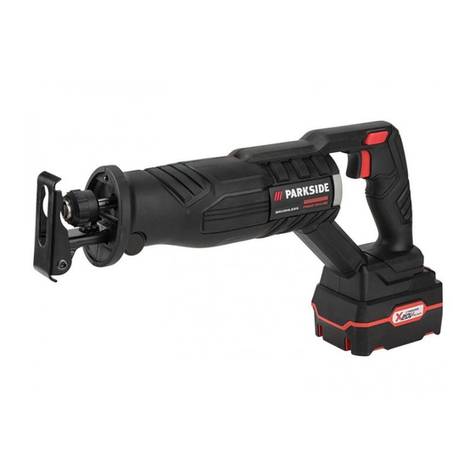
Parkside Performance
Parkside Performance PSSAP 20-Li B2 Operation and safety notes
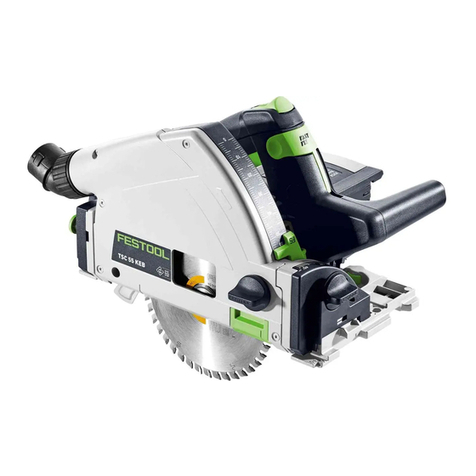
Festool
Festool TSC 55 KEB Original instructions
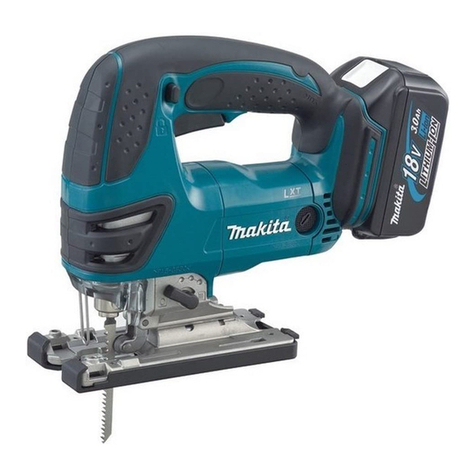
Makita
Makita DJV180RFE instruction manual
